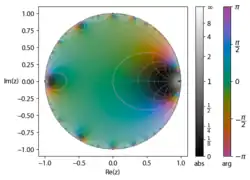Domain coloring plot of ϕ on the complex plane In mathematics , the Euler function is given by
ϕ
(
q
)
=
∏
k
=
1
∞
(
1
−
q
k
)
,
|
q
|
<
1.
{\displaystyle \phi (q)=\prod _{k=1}^{\infty }(1-q^{k}),\quad |q|<1.}
Named after Leonhard Euler , it is a model example of a q -seriescombinatorics and complex analysis .
Properties
The coefficient
p
(
k
)
{\displaystyle p(k)}
formal power series expansion for
1
/
ϕ
(
q
)
{\displaystyle 1/\phi (q)}
partitions of k . That is,
1
ϕ
(
q
)
=
∑
k
=
0
∞
p
(
k
)
q
k
{\displaystyle {\frac {1}{\phi (q)}}=\sum _{k=0}^{\infty }p(k)q^{k}}
where
p
{\displaystyle p}
partition function .
The Euler identity , also known as the Pentagonal number theorem , is
ϕ
(
q
)
=
∑
n
=
−
∞
∞
(
−
1
)
n
q
(
3
n
2
−
n
)
/
2
.
{\displaystyle \phi (q)=\sum _{n=-\infty }^{\infty }(-1)^{n}q^{(3n^{2}-n)/2}.}
(
3
n
2
−
n
)
/
2
{\displaystyle (3n^{2}-n)/2}
pentagonal number .
The Euler function is related to the Dedekind eta function as
ϕ
(
e
2
π
i
τ
)
=
e
−
π
i
τ
/
12
η
(
τ
)
.
{\displaystyle \phi (e^{2\pi i\tau })=e^{-\pi i\tau /12}\eta (\tau ).}
The Euler function may be expressed as a q -Pochhammer symbol
ϕ
(
q
)
=
(
q
;
q
)
∞
.
{\displaystyle \phi (q)=(q;q)_{\infty }.}
The logarithm of the Euler function is the sum of the logarithms in the product expression, each of which may be expanded about q = 0, yielding
ln
(
ϕ
(
q
)
)
=
−
∑
n
=
1
∞
1
n
q
n
1
−
q
n
,
{\displaystyle \ln(\phi (q))=-\sum _{n=1}^{\infty }{\frac {1}{n}}\,{\frac {q^{n}}{1-q^{n}}},}
which is a Lambert series with coefficients -1/n . The logarithm of the Euler function may therefore be expressed as
ln
(
ϕ
(
q
)
)
=
∑
n
=
1
∞
b
n
q
n
{\displaystyle \ln(\phi (q))=\sum _{n=1}^{\infty }b_{n}q^{n}}
where
b
n
=
−
∑
d
|
n
1
d
=
{\displaystyle b_{n}=-\sum _{d|n}{\frac {1}{d}}=}
OEIS A000203 )
On account of the identity
σ
(
n
)
=
∑
d
|
n
d
=
∑
d
|
n
n
d
{\displaystyle \sigma (n)=\sum _{d|n}d=\sum _{d|n}{\frac {n}{d}}}
σ
(
n
)
{\displaystyle \sigma (n)}
sum-of-divisors function , this may also be written as
ln
(
ϕ
(
q
)
)
=
−
∑
n
=
1
∞
σ
(
n
)
n
q
n
{\displaystyle \ln(\phi (q))=-\sum _{n=1}^{\infty }{\frac {\sigma (n)}{n}}\ q^{n}}
Also if
a
,
b
∈
R
+
{\displaystyle a,b\in \mathbb {R} ^{+}}
a
b
=
π
2
{\displaystyle ab=\pi ^{2}}
[ 1]
a
1
/
4
e
−
a
/
12
ϕ
(
e
−
2
a
)
=
b
1
/
4
e
−
b
/
12
ϕ
(
e
−
2
b
)
.
{\displaystyle a^{1/4}e^{-a/12}\phi (e^{-2a})=b^{1/4}e^{-b/12}\phi (e^{-2b}).}
Special values
The next identities come from Ramanujan 's Notebooks:[ 2]
ϕ
(
e
−
π
)
=
e
π
/
24
Γ
(
1
4
)
2
7
/
8
π
3
/
4
{\displaystyle \phi (e^{-\pi })={\frac {e^{\pi /24}\Gamma \left({\frac {1}{4}}\right)}{2^{7/8}\pi ^{3/4}}}}
ϕ
(
e
−
2
π
)
=
e
π
/
12
Γ
(
1
4
)
2
π
3
/
4
{\displaystyle \phi (e^{-2\pi })={\frac {e^{\pi /12}\Gamma \left({\frac {1}{4}}\right)}{2\pi ^{3/4}}}}
ϕ
(
e
−
4
π
)
=
e
π
/
6
Γ
(
1
4
)
2
11
/
8
π
3
/
4
{\displaystyle \phi (e^{-4\pi })={\frac {e^{\pi /6}\Gamma \left({\frac {1}{4}}\right)}{2^{{11}/8}\pi ^{3/4}}}}
ϕ
(
e
−
8
π
)
=
e
π
/
3
Γ
(
1
4
)
2
29
/
16
π
3
/
4
(
2
−
1
)
1
/
4
{\displaystyle \phi (e^{-8\pi })={\frac {e^{\pi /3}\Gamma \left({\frac {1}{4}}\right)}{2^{29/16}\pi ^{3/4}}}({\sqrt {2}}-1)^{1/4}}
Using the Pentagonal number theorem , exchanging sum and integral , and then invoking complex-analytic methods, one derives[ 3]
∫
0
1
ϕ
(
q
)
d
q
=
8
3
23
π
sinh
(
23
π
6
)
2
cosh
(
23
π
3
)
−
1
.
{\displaystyle \int _{0}^{1}\phi (q)\,\mathrm {d} q={\frac {8{\sqrt {\frac {3}{23}}}\pi \sinh \left({\frac {{\sqrt {23}}\pi }{6}}\right)}{2\cosh \left({\frac {{\sqrt {23}}\pi }{3}}\right)-1}}.}
References
Category
